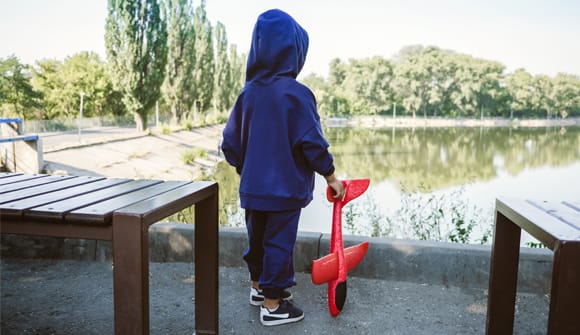Autism wandering warning
Tips to prevent tragedy in water.
Article Author: Guest Columnist
Article Date:

Our guest columnist is Lauren Papke, MS, CCC-SLP, speech-language pathologist and Autism Program lead at Wolfson Children’s Rehabilitation Autism and Neurodevelopment Center.
For most people, the word “elopement” brings to mind a picture of a couple privately exchanging vows. But for families with children with autism spectrum disorder (ASD), the word means something entirely different.
Children with ASD and associated developmental conditions are nearly four times more likely to wander off (elope), and half of children with ASD attempt to elope from a safe environment, according to the National Autism Association. This can happen quickly, even under adult supervision.
When a child wanders, he or she risks exposure to potential hazards such as busy roads and unsecured waterways. Children with autism may enjoy playing with water as it stimulates many of their senses. Despite being drawn to water, many children with ASD do not know how to swim.
Children with ASD, and those with intellectual disabilities, also have difficulties judging danger and effectively communicating. This puts them at greater risk for injury, and sometimes death, following elopement.
Why children wander
Kids and teens with autism and related disabilities may elope for a variety of reasons, including:
- Seeking a preferred object or activity (i.e., a pond, swimming pool or playground).
- Running and exploring for fun and enjoyment.
- Escaping a perceived stressful event (common in schools or loud environments).
- Coping with difficulty sleeping.
Prepare to protect
Parents and guardians of children with ASD can take some simple steps to ensure their child’s safety.
Plan
- Create an Elopement Emergency Response Plan outlining how your family will communicate with each other, where you will go and what you will do in the event your child wanders off. The National Autism Association’s Big Red Safety Toolkit provides a template.
- Alert trusted neighbors that you have a child with autism in your home.
- Notify first responders about your child and report nearby water sources.
- Monitor your child for changes in behavior.
- Look for the reason(s) “why” your child might elope.
- Write your name and contact information on ID bracelets or shoe tags.
- Consider getting a personal tracking device, such as a GPS-equipped wristband.
Secure
- Provide a safe environment, free of common household hazards. Think of this like baby-proofing, but specific to your child’s needs.
- Equip your home with keyless locks, as well as alarms or chimes on doors and windows.
- Add additional protective measures to pools.
Teach safety
- Help your child learn how to respond to safety commands such as “stop.” Practice this skill.
- Make sure your child has swimming/water safety lessons.
- Teach your child to state his/her name, address, and phone number and/or to show ID in case he or she gets lost or wanders away.
Tragedies can happen in an instant. If your child has ASD or an intellectual disability, it’s never too early to secure your home and takes steps to prevent elopement.
Safe Kids Northeast Florida, led by THE PLAYERS Center for Child Health at Wolfson Children’s Hospital, has educational resources to promote water safety for kids of all ages. To learn about services for children with autism spectrum disorder offered through Wolfson Children’s Rehabilitation, call the Autism and Neurodevelopment Center at 904.346.0394.



